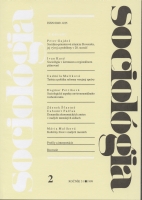Sociálno-priestorová situácia Slovenska, jej vývoj a problémy v 20. storočí
Socio-Spatial Situation in Slovakia and its Problems and Development in the 20th Century
Author(s): Peter GajdošSubject(s): Social Sciences
Published by: Sociologický ústav - Slovenská akadémia vied
Keywords: Socio-spatial situation; development; urbanization; industrialization
Summary/Abstract: Socio-Spatial Situation in Slovakia and its Problems and Development in the 20th Century. The article discusses the historical development of socio-spatial situation in Slovakia; concentrating especially on its developmental problems resulting in unfavorable conditions of this contemporary situation influenced also by social, demographic, economic, ecological and civilization problems. It focuses on the analysis of the regional level of society in the 20th century with a special attention being paid to the period of the industrial urbanization. The first part presents the circumstances related to the shift in the civilization basis of society’s development, its supposed sources and influence on the socio-spatial organization of Slovak society. The original situation in the first half of the 20th century was difficult, due to the delay in industrial and urbanization processes, which later became intensified in the 1950’s. As the context and impacts of the shift from agrarian to industrial society as well as the transformation from rural to urban society indicate, these shifts were asynchronic, notably the urbanization process was significantly delayed. The second part pays attention to the factors influencing the formation of socio-spatial situation of society, presenting how the industrialization and urbanization processes intensified the industrial and social development of society. It points at the specific features of accelerated industrial urbanization, which were during socialism influenced mainly by concentration, centralization and state paternalism. Moreover, the text deals with how these factors influenced the socio-spatial situation of society when besides the undeniable modernization effects had also caused significant problems and imbalances such as the deepening of differentiation and polarization of regional and residential development, and the shaping of marginal territories and residences. The specific effects of urbanization process are analyzed from the point of view of social, socio-economic, socio-demographic and socio-cultural sphere of society, as well as the impacts of this process on regional and residential communities and their developmental dispositions. Concluding part focuses on the contemporary socio-spatial situation, going through a multilateral transformation in which the unsolved problems of previous periods are mixed with the new problems of present period. This situation is marked by the formation of a new polarization displayed in different potential and developmental dispositions of regions and various types of residences. Deepening social disparities are characterized by social inequalities, which result from the characteristics of the social potentials. Thus, along with spatial disparities, social disparities are deepening as well, both being concentrated in specific regions. Sociológia 1999 Vol. 31 (No. 2: 111-140)
Journal: Sociológia - Slovak Sociological Review
- Issue Year: 1999
- Issue No: 2
- Page Range: 111-140
- Page Count: 30
- Language: Slovak

